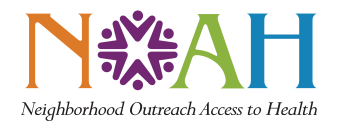By Zach Clay, Licensed Marriage, Family, and Child Therapy
During this unprecedented and often challenging time in the world, we need to consider the impact everything has on children. The COVID-19 pandemic can be particularly tough for children’s mental health and their ability to learn. NOAH’s Behavioral Health team shares expert insight, best practices, and resources in this series of posts to help children maintain mental health in the era of COVID-19, social distancing, and distance learning.
Adjusting to Changes in School and Learning
School is important for children. Even with more children learning through homeschooling or virtual schools before the COVID-19 pandemic hit, most children were still attending school in-person. When schools had to close and switch to remote learning in early 2020, children and families across the county faced a major adjustment.
While education is the primary goal, the school environment also provides access to friends, teachers, routines, and so much more. All of these things are critical for children’s academic and social development. On top of that, many students rely on schools for mental health care, along with nutritious and consistent meals.
Children experienced these changes while living through the uncertainty because of COVID and things outside of their control. That is a lot to ask of our kids.
How to best support children’s learning
Regardless of whether school is virtual or in-person for your child, this school year is different. Navigating remote learning or new rules, restrictions, and cancellations of regular school activities will be something parents and children need to do. Here are a few tips:
- Set and keep a routine. Children benefit from routines, particularly in stressful times. Routines offer people of all ages comfort and predictability, so parents and other caregivers benefit too. Setting and keeping routines help children cope and can make school time more productive. More on coping skills for children in our next post!
- Understand that (mis)behavior is often caused by emotions. Often times, a child may misbehave or have negative reactions for basic, emotional reasons. Frustrations with remote learning, cancelled parties, or other disappointments and unmet expectations can cause these emotions and behaviors. As the parent or caregiver, make the connection first to help change the behavior.
- Develop important life skills. Remote learning can help children learn important self-regulation skills. Virtual classrooms and independent classwork offer the chance to set new goals, be accountable and independent, and learn to adapt if needed.
- Be engaged in their education. This is always important for parents and caregivers to do. Ask about what children are learning and what they think is interesting. Help them organize their school day if it is virtual. Guide them through big assignments, help set goals, and give them choices about how you can help.
Monitor screen time
Screens are part of our daily lives. Before the pandemic, kids may be used to screens for fun activities like watching shows, being creative, and connecting with friends. Now, screen time might also be their classroom, group activity, class project and other extracurricular activities increasing their screen time even more. Here are some tips for managing screen time:
- Kindness and some compassion go a long way. We are living through a once-in-a-lifetime event with the COVID-19 pandemic. A little unstructured screen time may be an important break or comfort for many kids. Letting your kids know that you understand their needs is a simple way to reduce stress for everyone.
- Screen time can be a bonus. Try using extra screen time as an incentive for good behavior. If you try this, let your child know exactly what they need to do to earn the extra time. Write down the goal together and post it in their workspace as a reminder.
- Keep a schedule. This can be part of the routine mentioned above. It’s helpful for kids to know when they’ll be allowed to use their devices. For example, maybe they always get 30 minutes before dinner. That structure helps kids know what to expect and can limit their requests for more screen time.
- Set the example. It is so important for parents and caregivers to lead by example. If you set down your phone or tablet during set times (during dinner, after school/work, etc.), your children will be more likely to do the same. Plus, we all need to take breaks from technology and media, and we can all benefit from less time with our devices, and more moments with our kids.
Remember, we are all living through a challenging time, and children are experiencing everything happening around them. Spend some quality time with your child, which is proven to help kids feel appreciated and loved and gives them confidence in adapting to changes. NOAH offers comprehensive behavioral health services to help parents, children, and families during COVID-19 challenges, remote learning adjustments, and everyday life.
Above all, parents should know this: Do the best that you can. Your child appreciates it, even if they don’t show it now.

